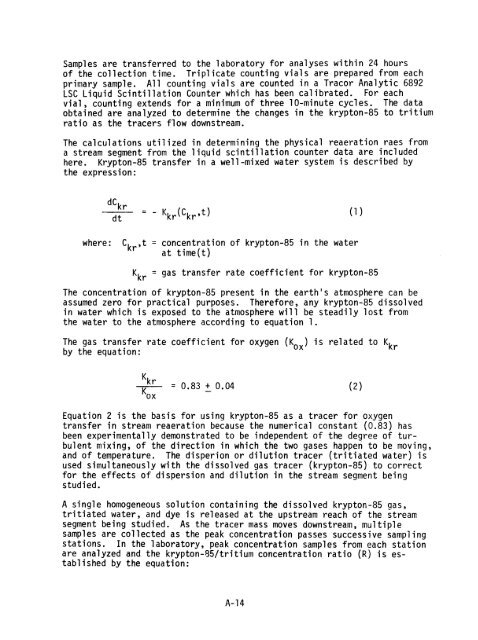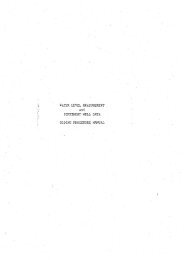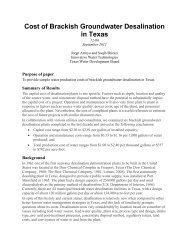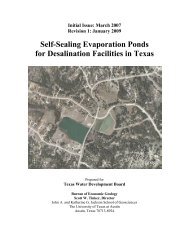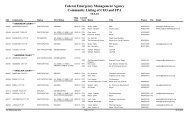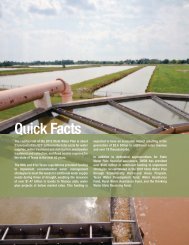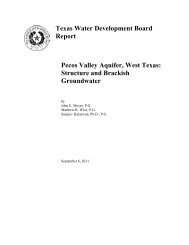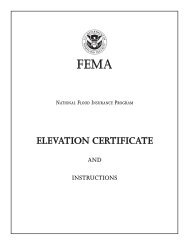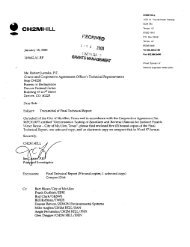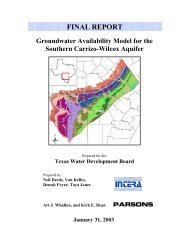Intensive Survey of the Guadalupe River Segment 1806
Intensive Survey of the Guadalupe River Segment 1806
Intensive Survey of the Guadalupe River Segment 1806
You also want an ePaper? Increase the reach of your titles
YUMPU automatically turns print PDFs into web optimized ePapers that Google loves.
Samples are transferred to <strong>the</strong> laboratory for analyses within 24 hours<br />
<strong>of</strong> <strong>the</strong> collection time. Triplicate counting vials are prepared from each<br />
primary sample. All counting vials are counted in a Tracor Analytic 6892<br />
LSC Liquid Scintillation Counter which has been calibrated. For each<br />
vial, counting extends for a minimum <strong>of</strong> three 10-minute cycles. The data<br />
obtained are analyzed to determine <strong>the</strong> changes in <strong>the</strong> krypton-85 to tritium<br />
ratio as <strong>the</strong> tracers flow downstream.<br />
The calculations utilized in determining <strong>the</strong> physical reaeration raes from<br />
a stream segment from <strong>the</strong> liquid scintillation counter data are included<br />
here. Krypton-85 transfer in a well-mixed water system is described by<br />
<strong>the</strong> expression:<br />
'kr<br />
- K. (C. ,t) (1)<br />
dt " " ^kr^kr<br />
where: Cbv,,t = concentration <strong>of</strong> krypton-85 in <strong>the</strong> water<br />
'kr5<br />
at time(t)<br />
K. = gas transfer rate coefficient for krypton-85<br />
The concentration <strong>of</strong> krypton-85 present in <strong>the</strong> earth's atmosphere can be<br />
assumed zero for practical purposes. Therefore, any krypton-85 dissolved<br />
in water which is exposed to <strong>the</strong> atmosphere will be steadily lost from<br />
<strong>the</strong> water to <strong>the</strong> atmosphere according to equation 1.<br />
The gas transfer rate coefficient for oxygen (K ) is related to Kk<br />
by <strong>the</strong> equation: x r<br />
kr = 0.83 + 0.04 (2)<br />
Kox<br />
Equation 2 is <strong>the</strong> basis for using krypton-85 as a tracer for oxygen<br />
transfer in stream reaeration because <strong>the</strong> numerical constant (0.83) has<br />
been experimentally demonstrated to be independent <strong>of</strong> <strong>the</strong> degree <strong>of</strong> tur<br />
bulent mixing, <strong>of</strong> <strong>the</strong> direction in which <strong>the</strong> two gases happen to be moving,<br />
and <strong>of</strong> temperature. The disperion or dilution tracer (tritiated water) is<br />
used simultaneously with <strong>the</strong> dissolved gas tracer (krypton-85) to correct<br />
for <strong>the</strong> effects <strong>of</strong> dispersion and dilution in <strong>the</strong> stream segment being<br />
studied.<br />
A single homogeneous solution containing <strong>the</strong> dissolved krypton-85 gas,<br />
tritiated water, and dye is released at <strong>the</strong> upstream reach <strong>of</strong> <strong>the</strong> stream<br />
segment being studied. As <strong>the</strong> tracer mass moves downstream, multiple<br />
samples are collected as <strong>the</strong> peak concentration passes successive sampling<br />
stations. In <strong>the</strong> laboratory, peak concentration samples from each station<br />
are analyzed and <strong>the</strong> krypton-85/tritium concentration ratio (R) is es<br />
tablished by <strong>the</strong> equation:<br />
A-14


